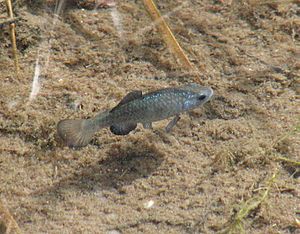Sonoyta pupfish facts for kids
Quick facts for kids Sonoyta pupfish |
|
|---|---|
 |
|
| A Quitobaquito pupfish in Organ Pipe Cactus National Monument, Arizona | |
| Conservation status | |
| Scientific classification | |
| Synonyms | |
|
Cyprinodon macularius eremus |
The Sonoyta pupfish or Quitobaquito pupfish (Cyprinodon eremus) is a small fish that is currently endangered. This means there are not many of them left in the wild. They live in Sonora, Mexico, and Arizona in the United States.
Scientists first thought this fish was a type of desert pupfish. But now they know it is its own special species.
Contents
What Does the Sonoyta Pupfish Look Like?
The Sonoyta pupfish has a thick, round body. Its mouth points upwards and has special teeth. Its scales have tiny spikes.
The colors of male and female pupfish are different:
- Females and young fish are silver. They have dark stripes on their sides. Their fins are usually clear, except for a dark spot on their top fin.
- Males that are ready to breed have darker fins and a light blue body. The back part of their tail is yellow or orange, sometimes even bright red.
Compared to other pupfish, the Sonoyta pupfish has a bigger head, mouth, and body. But its fins are smaller, and its tail base is shorter.
Where Does the Sonoyta Pupfish Live?
The Sonoyta pupfish lives in a very small area. This area is less than 11 square kilometers (about 4 square miles).
In the United States, you can only find them in the Quitobaquito springs. These springs are part of the Gila River area in the Organ Pipe Cactus National Monument in Arizona. They also live just across the border in Mexico. In Mexico, they are found in two short parts of the Sonoyta River in Sonora.
What Kind of Home Does It Like?
Sonoyta pupfish live in springs, lakes, pools, and slow-moving streams. They like shallow water with lots of plants.
These fish are very tough! They can handle big changes in water temperature. They can also live in water that is three times saltier than the ocean. They can even survive in water hotter than 35 degrees Celsius (95 degrees Fahrenheit).
What Does the Sonoyta Pupfish Eat?
The Sonoyta pupfish eats both plants and animals. It is an omnivore. They eat things like:
- Small water plants
- Young insects (like larvae)
- Tiny water bugs
- Sponge
- Eggs from other water creatures
- Sometimes, even their own eggs!
Reproduction and Life Cycle
Male Sonoyta pupfish protect a small area from other males. They try to attract females to their territory. The female then lays her eggs randomly within this protected area. During the breeding season, the male's colors become much brighter and more intense.
How Are We Protecting the Sonoyta Pupfish?
The number of Sonoyta pupfish has gone down a lot. This is because their homes have changed, and other fish that are not native to the area compete with them or eat them. Also, harmful chemicals might blow over from Mexico.
However, the group of pupfish living in the Quitobaquito Springs is usually stable. Their numbers might go up and down with the seasons.
People are working to help these fish. They keep the pupfish's homes clean and free of fish that don't belong there. They also check on the health of the pupfish population often.
See also



